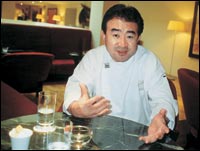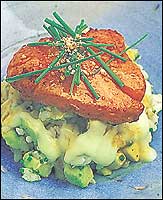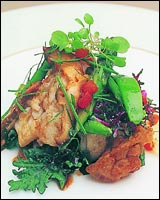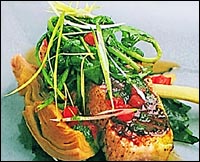


 Is Tetsuya Wakuda the Greatest Chef in the World
Is Tetsuya Wakuda the Greatest Chef in the World
ASIT CHANDMAL, who wined and dined with the Japanese chef exclusively in London recently, thinks there is nobody like Tetsuya Wakuda... and he lists his reasons why. |
|
NEWSPAPERS and magazines sometimes ask the world�s most renowned chefs for their list of the culinary geniuses they admire the most. Three names appear on everyone�s list: Tetsuya Wakuda, Ferran Adria and Alain Ducasse. The others often mentioned are Charlie Trotter, Thomas Keller, Daniel Boulud, and Nobuyuki Matsuhisa. Of these Tetsuya is my personal favourite. He is currently, perhaps, the best chef in the world, if such a person exists. The prestigious New York Food & Wine Magazine critic said, "My meal at Tetsuya was the finest I had ever eaten." In 1982, at the age of 22, Tetsuya went to Sydney, Australia. He didn�t speak a word of English, and he had no money. He took a job washing dishes. He gradually taught himself French culinary techniques. In 1986 he started his own tiny restaurant together with the head waiter. By 2000 his eponymous restaurant in Sydney was fully booked out for several weeks, and had become a Mecca for gourmets, food writers and chefs from all over the world. In its latest incarnation Tetsuya�s occupies 21,000 square feet of space, with seats for only 60 customers. And there are over 50 members of staff! It has a Japanese garden, and is in the heart of Sydney. There is an eight course lunch menu and a 14 course dinner menu (see sample alongside). You aren�t given a choice, though the waiter does ask you if you have any allergies or any particular food you don�t like. If so, they will immediately substitute the offending dish with another spectacularly innovative dish! They even change the menu halfway if a supplier has delivered a particularly fresh and intriguing ingredient. A wonderfully appropriate wine by the glass is recommended with each course. If you want to order by the bottle, I strongly recommend Zind Humbrecht�s Herrenweg Riesling 1996... Tetsuya says, "For me a successful dish is when no one flavour overwhelms the other, but all exist harmoniously. There are no rules in food. You�ll find French influences in my food. Some dishes have Chinese roots, and others Japanese. The menu degustation is structured in a series of tiny tastes to highlight the entirety of the ingredients � their particular taste, texture, smell and look � whether they be from land, sea or earth. In Japanese tradition, the greater the variety of the food served, the greater is the host�s hospitality."
Food like this cannot be described. You have to taste it, savour it. For me it is like wind chimes in the mouth, Mozart melodies made edible. Last August hardly anyone in London had reviewed Mju and Tetsuya�s cuisine. The restaurant was empty but for some delighted Australians, ecstatic at the serendipidity of being able to walk in without a booking. During several meals which Tetsuya personally cooked for me, and one where Chris Behre did the honours, we had some instructive conversations about his ethereal food. (The same had happened when Nobu opened in London four years ago. In 1997 I used to sit and chat with Nobu while he and his staff had lunch. Just try to meet him now!) Tetsuya says, "In Osaka there exists a restaurant which seats eight people at a counter. The smallness of the restaurant is striking. I want to capture the essence of this restaurant � not because I aspire to turning away people who want to eat but because of the attention the owner chef lavishes on the little details." Tetsuya�s is really French food heavily influenced by Japanese culinary philosophy and ingredients. Not one other chef in the world has dared to take on the most vaunted cuisine in the world and transformed it into something even better. Consider his roast scampi with tea and shellfish oil. Or the lobster ravioli with seaweed vinagrette and shellfish essence. The Ceylon tea brings out the sweetness of the scampi, and the shellfish oil (and the shellfish essence) gives it the taste of the sea. Tetsuya frequently uses seaweed e.g. konbu (kelp), hijiki, ogonori, and wakame, as well as dashi, bonito, sake, soya, mirin, and dried mushrooms. He ensures that a high degree of amino acids brings out the fullest flavours. The best oysters in London are served at Nobu and by Tetsuya. Nobu has oysters in five different dressings, whereas the latter serves his with rice wine vinaigrette. He gives the oysters (and other seafood) a coating of oil so that they go better with wine. However the ideal accompaniment for oysters, he tells me, is sake, because it is five times less acidic than wine, so it does not leave behind a metallic or fishy taste. (Remember that Japanese food does not go well with wines.) "I love sake and oysters or even better very fine sake and caviar � it�s better than sex." Tetsuya�s carpaccio of sea scallops with foie gras, with citrus soy sauce, is an unique and dazzling variation on popular ingredients. His signature dish is his confit of Petuna ocean trout with fennel salad, (substituted with salmon in London), encrusted with roasted seaweed, laid on marinated celery, and garnished with ocean trout roe. Such creations are the result of patient and hard work. The confit of ocean trout took three months of experimenting with the temperature, till he got the vivid colour, the taste, and the texture right. And yet the cooking time varies everyday depending on the thickness of the trout delivered daily. Tetsuya�s flourless chocolate cake took eight months before it scaled Himalayan heights. His floating island (a poached meringue), with vanilla bean and praline anglaise, chocolate and raspberry hidden inside, is one of the finest creations on earth. It took him and half a dozen of his chefs one year to develop and is an ethereally light dessert! Tetsuya gave me some insight into the false starts and the evolution of the final recipe. I defy anyone to reproduce it. (One of the key ingredients is rosemary, believe it or not, to remove the eggy taste.)
Tetsuya himself says, "If I have to pick one restaurant it would be El Bulli in Barcelona. The chef there, Ferran Adria, is a marvellous cook. Whatever dish he�s working on, he breaks down into its components and rebuilds it his way. The contrast in texture and temperature is as important as the elements of sight, taste and smell and also there is an element of joy. His food is a real inspiration." Tetsuya has no family. He treats his staff as his family and they are incredibly loyal to him. "One lady has stayed with me for 16 years, though she has left three husbands during that time!" he says laughing. There are no histrionics or shouting and rudeness in the kitchen (British chefs take note). The food on your table reflects this peace and harmony. Tetsuya is very close to Nobu, whom he praises in the highest possible terms (he also talks very admiringly about Adria, Ducasse and Trotter, who he has cooked for and who have cooked for him). I asked him for the secret of Nobu�s famous �Black Cod in Miso Sauce�, a dish much imitated, without success, by the chefs of the West. Tetsuya smiled enigmatically and started, "There is an old Japanese cooking technique called Saikyo Yaki...". I was enthralled, being made privy to the world�s most sought after recipe. Tetsuya is such a genuinely open person, so frank about his trials and tribulations, his philosophy and success, his passion for food, and such a good conversationalist that I could listen to him for hours. The late oil billionaire, Nubar �Mr. 5 Per Cent� Gulbenkian, was once asked: Who is your favourite dining companion? His answer: "Myself, and a damn good head waiter." I would modify this: "Myself and Tetsuya, while dining on his food." Tetsuya's 14-Dinner Menu for the author�s wedding anniversary  Campari & Grapefruit Cocktail
Campari & Grapefruit Cocktail
Click for recipe |

Home Page
 And now you don�t have to go to Sydney to eat his food. The Malaysian millionaire Quek Leng Beng persuaded Tetsuya to cook at his Millennium Hotel in Knightsbridge, London. The restaurant is called Mju. Tetsuya cooks there one week in the month. The rest of the time Chris Behre, trained by Tetsuya for several years, stands in brilliantly for the master.
And now you don�t have to go to Sydney to eat his food. The Malaysian millionaire Quek Leng Beng persuaded Tetsuya to cook at his Millennium Hotel in Knightsbridge, London. The restaurant is called Mju. Tetsuya cooks there one week in the month. The rest of the time Chris Behre, trained by Tetsuya for several years, stands in brilliantly for the master.
 Tetsuya uses a lot of caviare in London because it is banned in Australia. He uses salmon instead of ocean trout because he is unable to get it in Europe. Like Ferran Adria and Charlie Trotter, he has a special kitchen, a laboratory, in his restaurant where he is constantly experimenting with taste and texture. He told me, "There is no such thing as perfection, that is why I am constantly excited by the challenge of cooking." And, "You have to have madness." Tetsuya Wakuda�s food is so good that I have no hesitation in saying that a dinner at Tetsuya�s is the finest gastronomic experience in the world, with only one exception: Ferran Adria�s 24 course dinner at El Bulli, a two-hour drive from Barcelona. (Adria closes his three Michelin star restaurant for five months in the year. Madness?)
Tetsuya uses a lot of caviare in London because it is banned in Australia. He uses salmon instead of ocean trout because he is unable to get it in Europe. Like Ferran Adria and Charlie Trotter, he has a special kitchen, a laboratory, in his restaurant where he is constantly experimenting with taste and texture. He told me, "There is no such thing as perfection, that is why I am constantly excited by the challenge of cooking." And, "You have to have madness." Tetsuya Wakuda�s food is so good that I have no hesitation in saying that a dinner at Tetsuya�s is the finest gastronomic experience in the world, with only one exception: Ferran Adria�s 24 course dinner at El Bulli, a two-hour drive from Barcelona. (Adria closes his three Michelin star restaurant for five months in the year. Madness?)